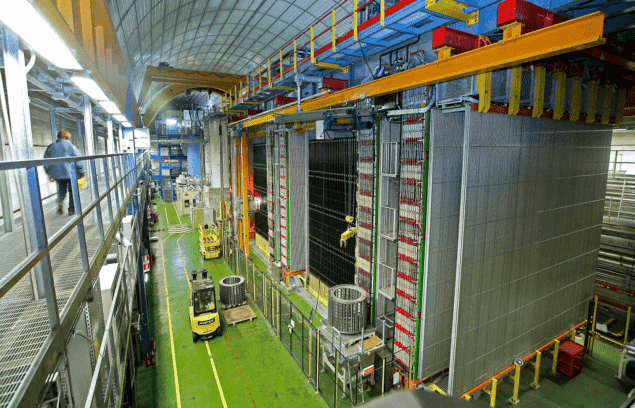
Five more tau neutrinos have been uncovered in a fresh analysis of data taken by the OPERA neutrino detector in Italy, bringing the total number of detections to 10. The analysis establishes the “oscillation”, or changing, of muon neutrinos into tau neutrinos at a statistical significance of 6.1σ. This is well above the level normally required for a discovery in particle physics (5σ). It is also much better than OPERA’s previous result of 5.1σ, which was published in 2015 based on the detection of five tau neutrinos.
Located deep within a mountain at the Gran Sasso National Laboratory in Italy, OPERA ran between 2008 and 2012. Researchers there studied a beam of muon neutrinos that had been created at CERN in Switzerland before travelling 730 km under the Alps to arrive at Gran Sasso. Along the way, some of these neutrinos changed their flavour and became tau neutrinos. This neutrino oscillation indicates that neutrinos have mass, which is not predicted by the Standard Model of particle physics. Gaining a better understanding of the properties of neutrinos could therefore provide an answer to the mystery of why there is so much more matter than antimatter in the universe.
Writing in Physical Review Letters, OPERA physicists describe how they have used their new result to calculate the absolute value of the square of the mass difference between the two neutrino mass eigenstates (m2 and m3). This is the first such calculation based on measurements of the appearance of tau neutrons and agrees with the mass difference calculated from experiments that measure the disappearance of muon neutrinos.
Completely new strategy
“We have analysed everything with a completely new strategy, taking into account the peculiar features of the events,” explains Giovanni De Lellis spokesperson for the OPERA collaboration. Based at the University of Naples, De Lellis adds: “We also report the first direct observation of the tau neutrino lepton number, the parameter that discriminates neutrinos from their antimatter counterpart, antineutrinos.” He also points out that OPERA’s performance has exceeded the collaboration’s expectations.
The collaboration has also made its data available to the public on the CERN Open Data Portal. This is the first time that data not associated with the Large Hadron Collider has been made public in this way.
OPERA hit the headlines in 2011 when it appeared that neutrinos were travelling from CERN to Gran Sasso faster than the speed of light. If correct, superluminal neutrinos would have been the discovery of the century – however, the anomalous measurement turned out to be the result of previously-unknown problems with the detector. In the audio interview below, the former OPERA spokesperson Antonio Ereditato explains how the experiment works and reflects on the how the collaboration dealt with the superluminal result.



